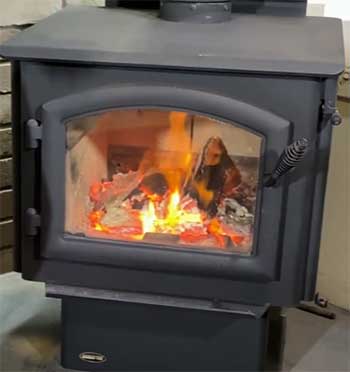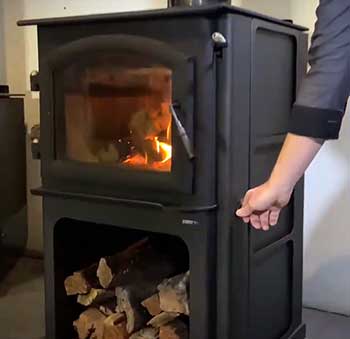Wood stoves provide a classic and charming way to heat your home. Watching the flames dance behind the glass door can make any space feel cozy and inviting. However, as with any appliance, wood stoves can develop issues over time.
Understanding common problems with Quadra-Fire wood stoves can help you resolve them quickly.
Typical Problems With Quadra-Fire Wood Stove
Several key problems may arise with Quadra-Fire wood stoves:
- Not Enough Heat Output
- Smoking Out the Door
- Creosote Buildup in Chimney
- Overfiring
- Rust Accumulation
- Catalytic Combustor Failure
- Blowers Not Working
- Glass Door Gasket Leakage
Let’s talk about these problems in detail.
Not Enough Heat Output
A major frustration with wood stoves is when they don’t seem to be producing enough heat. There are a few possible reasons for low heat output:

- Wood Not Dry Enough: For proper combustion and heat production, wood must have a moisture content below 20%. Burning wet or unseasoned wood prevents your stove from reaching high temperatures.
- Wood Piece Too Large: Large logs can smother the fire. Opt for smaller split logs no more than 6 inches long and 2-3 inches thick. This allows for sufficient airflow to the fire.
- Dirty Firebox: Ash and soot buildup on the walls of the firebox act as insulators that inhibit heat transfer. Routinely empty ashes and clean the firebox to maximize heat output.
- Bad Draft: An improper draft means the stove can’t pull in enough oxygen for complete combustion. Check the chimney and stovepipe for blockages.
Smoking Out the Door
Seeing smoke pour out of the stove door as you open it indicates incomplete combustion. Possible causes include:
- Closing Air Inlets Too Soon: Leave the air inlets fully open for at least 15-30 minutes after starting the fire or adding wood. This ensures the fire gets enough oxygen during the critical early stages.
- Burning Unseasoned Wood: As mentioned above, wet wood prevents the fire from reaching high enough temperatures, resulting in poor burning and smoke.
- Overloading the Firebox: Cramming too many logs into the stove at once restricts airflow. Only burn the recommended amount of wood per load.
- Using Green Wood: Even seasoned wood contains some moisture. Allow freshly cut “green” wood to dry and season for 6-12 months before burning to prevent smoking issues.
Creosote Buildup in Chimney
Creosote is a tar-like byproduct of burning wood. It’s created when smoke condenses on the relatively cooler chimney walls. A glazed, black creosote buildup indicates your stove is burning inefficiently and producing excess smoke. Heavy creosote deposits increase the risk of a chimney fire. Minimize creosote by burning only dry, seasoned wood and ensuring proper airflow through regular chimney cleanings.
Overfiring
It’s possible to get carried away stoking a roaring fire in your wood stove. But continuously burning the stove at extremely high temperatures can damage the cast iron or steel. Signs of overfiring include:
- Warping/Buckling metal
- Paint discoloration/Bubbling
- Excessive creosote buildup
Avoid overfiring by not overloading the stove and letting the fire burn down between adding more wood. Install a magnetic stove thermometer and don’t exceed temperatures above 600°F for extended periods.
Rust Accumulation
With continual high heat exposure, steel components on a wood stove can start to rust over time. Rusting is accelerated by moisture from wet wood or ash cleanup. Routinely inspect for rust spots and immediately clean and repaint affected areas to prevent worsening. For severe rust, sand and prime the area before repainting.
Catalytic Combustor Failure
Many Quadra-Fire wood stoves feature a catalytic combustor—a coated metal honeycomb—that burns smoke for extra efficiency and emissions control. The combustor can fail after 5-10 years from normal wear or due to improper use like burning garbage. Replacement combustors are readily available. Ensure proper break-in and maintenance to maximize the combustor’s lifespan.
Blowers Not Working
Quadra-Fire’s wood stoves with blowers use the stove’s own heat to push air into the room. If the blower isn’t running, the issue is likely a faulty snap disc that controls activation based on temperature. Snap discs can be readily replaced by a technician. The blower motor itself can also eventually fail and require replacement.
Glass Door Gasket Leakage
The glass door on a wood stove is sealed by a fiberglass rope gasket that hardens and deteriorates over time. Look for any smoke leakage around the door as an indicator that the gasket needs replacement. Fortunately, wood stove door gaskets are inexpensive and easy to swap out with simple hand tools.
Maintenance Tips For Quadra-Fire Wood Stove
Regular maintenance can prevent many common wood stove issues:

- Annually inspect the stovepipes and chimney. Replace any rusted, cracked, or blocked sections.
- Check door gaskets for leakage and replace worn out gaskets.
- Empty the firebox of ashes before they reach 2-3 inches deep.
- At the end of each burning season, give the entire stove a thorough cleaning to remove soot, ash, and creosote.
- Repair any cracked refractory bricks or baffle components that direct heat and airflow.
- Inspect for rust and immediately repaint affected areas.
- Monitor catalytic combustors and replace when needed.
With proper care and maintenance, a quality wood stove like those made by Quadra-Fire can provide decades of reliable service. Paying attention to potential issues and addressing them promptly will keep you cozy and warm all winter long.
Also Read: How Jetboil Sumo And MiniMo Stoves Are Different?
Frequently Asked Questions (FAQ)
With proper maintenance and care, a high-quality wood stove should last upwards of 25-30 years before needing complete replacement. Individual components like the catalytic combustor may need replacement every 5-10 years with regular use. The stove’s lifespan also depends on the quality of materials used in manufacturing. Quadra-Fire uses heavy-gauge steel and cast iron to ensure years of durable heating performance.
If your wood stove isn’t producing its normal heat output, the most likely culprits are burning improper wood (too wet, unseasoned, or green), an overloaded firebox restricting airflow, or ash buildup insulating the firebox. First ensure you are burning only seasoned hardwood logs no more than 2-3 inches diameter. Remove any excess ashes or debris in the firebox that could be blocking airflow. Let the stove fully warm up before closing the air controls. If problems persist, inspect your flue and stovepipes for any blockages inhibiting the draft.
Quadra-Fire is a brand of wood stoves and inserts manufactured by Hearth & Home Technologies, Inc. The company was formed by the merger of Hearth Technologies and FMI in 1980. Based in Lakeville, Minnesota, Hearth & Home Technologies continues to produce Quadra-Fire wood stoves known for their quality steel construction and innovative features. As one of the largest hearth products companies in the industry, they have manufactured wood stoves for over 30 years.
Some clear signs your wood stove may be malfunctioning or in need of repair include: smoke leaking from the door gaskets, excessive creosote buildup in the chimney, rust spots on the exterior, warped or discolored steel from overfiring, blower fans not working properly, reduced heat output, unintended backdrafting of smoke into the room, and combustion byproducts or fumes smelling up the house. If your wood stove is exhibiting any of these issues, have it inspected by a professional to identify and properly fix the problem before continuing to use it. Trying to ignore symptoms of a faulty wood stove can lead to dangerous situations.
Wrapping Up
Quadra-Fire produces high-quality wood stoves that can provide years of reliable heating when properly maintained. However, like any appliance, they can develop common issues over time such as smoky emissions, creosote buildup, overfiring damage, and component failures.
Being aware of potential problems and addressing them promptly through regular maintenance and cleaning will keep your Quadra-Fire wood stove running safely and efficiently for the long haul.
Proper operation is also key, so be sure to burn only seasoned wood and give plenty of airflow.
With its heavy-duty construction, a well-cared-for Quadra-Fire stove will continue producing cozy radiant heat to get you through many winters.

